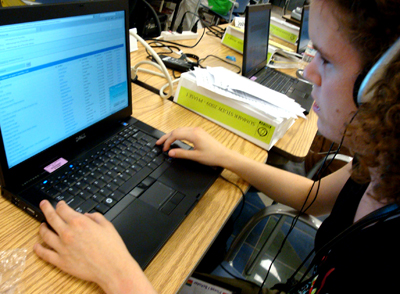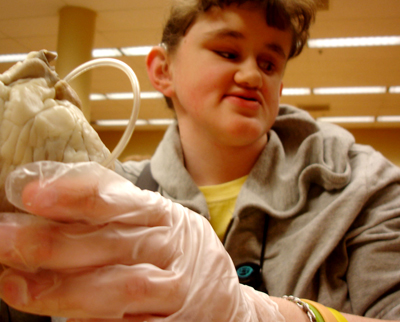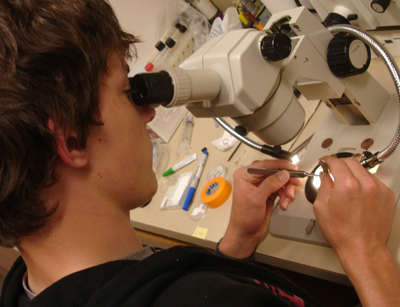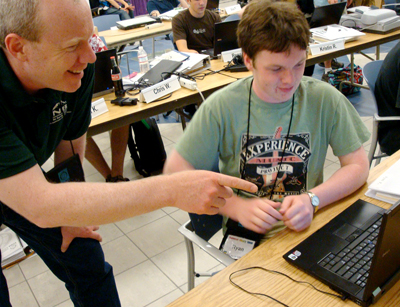Learning Styles
Research Question
What do we know about learning styles that can guide the delivery and design of professional development for faculty and administrators regarding equal access of students with disabilities to courses and programs?
Overview of Research
How learners learn is as important to consider as the content being taught. Learner-centered education strives to make both content and methods appropriate for the learner (Conti, 1998). Although learning is an individual event, it often occurs in a group setting (Felder, 1996). In any group, the presenter can assume that participants have a variety of learning styles. Addressing learning style issues in the delivery of instruction can maximize its effectiveness.
"Learning style" refers to how an individual responds to the learning environment (Claxton & Ralston, 1978; Wooldridge, 1995). Dunn and Griggs (2000) describe learning style as the way an individual begins to concentrate on, process, internalize, and remember new information and skills. They report that learning style is an individual's reaction to several factors that include the following:
- the environment, such as room temperature or lighting;
- emotions, such as motivation and persistence;
- sociological factors, such as individual or group learning; and
- physiological factors, such as sensory preferences and variable energy levels.
In addition to the learning styles of students, it is important for presenters to be aware of their own learning preferences. An instructor's style may influence the activities chosen within the learning environment. Students will respond based on their own personal preferences. A mismatch between the learning styles of students and their instructor can interfere with learning and raise the discomfort level of students. Alternatively, when the learning styles of students are similar to those of an instructor, they may exhibit greater achievement and personal satisfaction (Felder, 1996; University of Illinois at Urbana-Champaign Office, Division of Instructional Development, 1998).

Sensory Preferences
Perhaps the most commonly used categories of learning styles are based on sensory preferences. Wooldridge (1995) describes learners with the following preferences.
Auditory Preferences
This category describes those who learn best by listening to verbal instruction such as a lecture, discussion, or recording. Coker (1996) describes this person as "the listener," preferring to rely on sounds to learn.
Visual Preferences
These learners use vision for their primary perceptual preference and can remember most easily what they read or observe. They can close their eyes to recall what they have read or seen earlier. Ness (1995) includes a separate category of "written word" in which the person has a preference for learning by reading as opposed to actually seeing objects or participating in activities in order to learn.
Tactile Preferences
Learners with tactile perceptual preferences often need to underline as they read, take notes when they listen, or keep their hands busy in other ways. Members of this group may never read the notes they write. Rather, the activity of writing is sufficient for the learning to occur (Ness, 1995).
Kinesthetic Preferences
For these learners, whole body movement and real life experiences are often needed to absorb and retain the material to be learned. They learn best when they are totally involved in an activity.

Experiential Learning
Another popular theoretical framework for learning styles is that of Kolb's "Experiential Learning" (Claxon & Ralston, 1978; Svinicki & Dixon, 1987). This theory explains how a person develops observations and reflections from a concrete experience. Abstract concepts are then formed which guide new behavior. Within this model, four specific learning styles emerge:
Converger
These learners work best when there is a simple and correct answer to a problem. Their dominant learning abilities are abstract conceptualization and active experimentation. These individuals prefer dealing with things rather than people and tend to excel in the physical sciences and engineering.
Diverger
These individuals learn best through concrete experience and reflective observation. A strength is their imaginative ability. They tend to be people-oriented, react with emotions, and excel in humanities and the liberal arts.
Assimilator
The dominant learning orientations of these people are abstract conceptualization and reflective observation. Abstract conceptualization activities include listening to lectures, writing papers, building models, completing projects, and developing analogies. Reflective observation activities include the use of logs, journals, discussion, brainstorming, thought questions, and rhetorical questions. Assimilators like to organize diverse items into an integrated whole. They are often interested in math and science fields.
Accommodator
Accommodators learn best through concrete experimentation. These activities include practicing in laboratories, collecting observations, reading primary text, participating in simulations and fieldwork, working problem sets, and studying examples and case studies. Accommodators like to have new experiences. They are intuitive and often use the trial-and-error strategy to solve problems. This type of learner often prefers technical or business fields.

Implications for Practice
Successful presenters employ a variety of teaching strategies in response to the diverse set of learning styles found within most groups. They also consider diversity in age, experience, intellect, and background. This is particularly important when teaching new material. Successful instructional techniques include the following (Felder, 1996).
- Teach theory by providing phenomena and problems that relate to the theory.
- Balance conceptual information with concrete information.
- Use a variety of sketches, plots, schematics, computer graphics, and physical demonstrations in addition to oral and written explanations in lectures and handouts.
- Provide plenty of time for reflection and discussion. Provide time for learners to think about the material being presented and organize their thoughts.
- Promote active participation and respond to individual questions. Also encourage faculty participants to use a variety of teaching strategies with their own students in order to address the different learning styles in their classes (Goad, 1997).
Sensory Preferences
Experiment with new techniques and strategies that may not be part of your own style. Some individuals learn better through listening, some through discussing, others through reading or watching, and still others through doing. Engage participants in a variety of learning activities that use multiple senses. Provide key information in multiple ways. Consider using videos, group discussions, mini-lectures, case studies, questions and answers, panels, and role-playing.

Experiential Learning
Experiential learning can be used in your faculty training by developing activities based on the common learning styles of different faculty groups. For example, business instructors may prefer activities designed for the accommodator; history, political science, English, and psychology faculty may be more receptive to activities for the diverger; economics, mathematics, sociology, and science instructors may find activities for the assimilator to be more effective; and those in engineering may prefer activities associated with the converger.
Conclusion
Create a learner-centered environment in training sessions for faculty and administrators. Expand your teaching style repertoire in order to accommodate all learners and encourage faculty to do the same to support the learning needs of their students. Use multiple instructional methods that engage different senses so that more learners, including those with disabilities, can learn effectively.